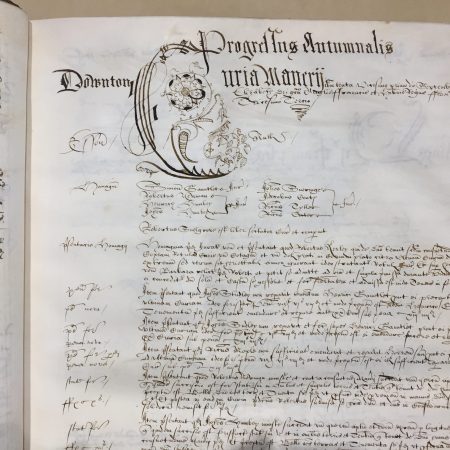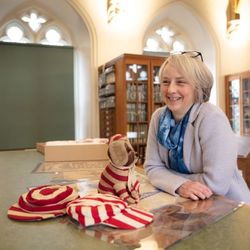
Author: Suzanne Foster, College Archivist, Winchester College
Bio: Suzanne qualified as an archivist in 1992 and came to work at Hampshire Record Office in the same year. She started work at Winchester College in 1999, working two days a week on a project which aimed to improve the storage, care and organisation of the College’s archives. Suzanne divided her time between HRO and Win Coll until August 2007 when she left the record office and became full time at Winchester College as College Archivist in 2007.
2022 marks the 100th anniversary of the Law of Property Act. This may not at first appear to be of great interest to archivists or historians but the Act abolished copyhold tenure and, with subsequent legislation in 1924, gave the Master of the Rolls jurisdiction over manorial records and gave them considerable legal protection. A mass of such records, therefore, survives in archives across the UK, including at Winchester College.
The College Archives, whilst they do include documents relating to our pupils and their education, may be said to be predominantly an archive relating to the estates that the College owned and managed. Winchester College was an institutional land owner on a similar scale to Winchester Diocese. Our Founder, William of Wykeham, gave the school a great deal of land by way of endowment – Downton Rectory Manor in Wiltshire and Eling Manor in Hampshire were the first gifts in 1385. Then came the manors of Coombe Bissett (Wiltshire), Ropley and Meonstoke, quickly followed by a mass of former alien priory land which included the manors of Harmondsworth (Middlesex), Hamblerice and Andwell (Hampshire), St Cross (Isle of Wight) and Titley (Herefordshire), and then by purchase, the manors of Vernham Dean (Hampshire) and Durrington (Wiltshire). Over the next 150 years, more property was added, either by purchase or by gift, including the manors of Fernhill in Hampshire and Merstone on the Isle of Wight.
The next big acquisition of lands came in the 1540s when the College was given a slew of ex-monastery land by Henry VIII in compensation for estates in Middlesex which the King wished to have to expand his estates around Hampton Court. The Middlesex lands included the manor of Harmondsworth, now a valuable piece of real estate near Heathrow Airport which includes a surviving medieval barn Harmondsworth Barn | English Heritage (english-heritage.org.uk), the building of which is mentioned in accounts preserved at Winchester College. The compensatory lands included the manors of Moundsmere, Stubbington and Woodmancote in Hampshire, the manors of Piddletrenthide, Sydling and Minterne in Dorset, the manors of Seavington, Milborne Port and Longload in Somerset, the manor of Ash in Surrey, and the manor of Salperton in Gloucestershire.
With all these acquisitions came deeds of title, manor court rolls and manorial accounts, all of which the Founder ordered the College to keep and preserve. In his Statutes for Winchester College, laid down in September 1400, Wykeham stated that: no manors, possessions, advowsons and patronage of churches were to be alienated; that the College should have ‘a common chest in which the said seal, charters, deeds, muniments, treasure, chalices, crosses, vestments, and precious jewels of the said College may be placed and must be guarded’; and that the Warden and Fellows were to visit the manors and estates twice a year to oversee their management, hold the courts and collect the rents.
Court Rolls for the College’s manors survive from the 1280s, and from 1556 to 1925 the records of all the manor courts were written up into a series of Court Books [image 1], a run of large and heavy volumes covering every court held on every manor. Manorial accounts were separately kept into the 1550s, and were then more patchily recorded in the Court Books for the remainder of the 16th century.
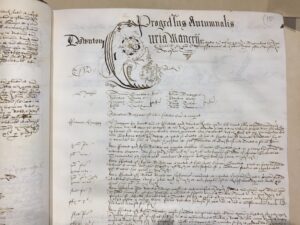
WCM: 23045. Court book 1591-1595, entry for Downton Manor dated September 1591
Then there are rentals, presentments, surveys, and a proliferation of what might be termed court papers from the 16th century onwards.
Manorial records are an excellent resource for anyone researching a building, a piece of land or a family who once lived in that manor. At Winchester, the fellows compiled a series of Indexes to Copyholds from the early 18th century which set out brief details of each exchange of tenant on each copyhold in each manor – an example from Eling is shown.
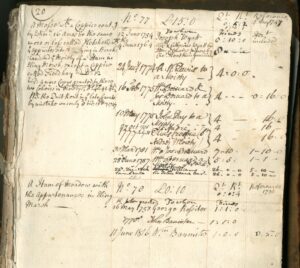
WCM: 23180. Index to Copyholds, c1733-c1821, entry for a copyhold on Eling manor
This gives us a way into the Court Books and the ability to quickly search for the name of a field or a tenant. One can then use the Court Books to try to track the history of that land holding back in time, sometimes, with good luck and a following wind, right back to the 16th century. We can do this because descriptions of land and copyholds remain essentially the same for hundreds of years.
For some manors, we have earlier copyhold indexes, and one particularly meticulous record was compiled by the steward of Eling manor and includes summary details of land transactions back to the 1380s.
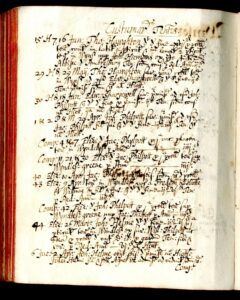
WCM: 6197. ‘Collectanea’ from Eling Court Rolls made by Edward Harris, steward of Eling Manor, in 1644
Alongside the court books, Winchester College also has rentals and surveys for its manors, and these give us the opportunity to pin-point the location of a copyhold and the rent received from it. An example of a map of from Sydling in Dorset is illustrated here.
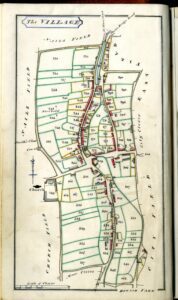
WCM: 21433. Map of the Manor of Sydling, 1831
Access to the main catalogues of our estate records, including the manorial records, is possible via this website https://winchestercollegearchives.org/ – just email me on sf@wincoll.ac.uk with a few details of what you are researching to get access. I’m afraid the documents themselves aren’t available on-line but researchers are welcome to come in and consult the documents in person or I can do some research for you.
To find out about the survival of manorial records more generally, check the Manorial Documents Register here Manorial Documents Register (nationalarchives.gov.uk). This database covers nearly all of England and Wales, with paper indexes held at the National Archives to cover the few counties not yet included

